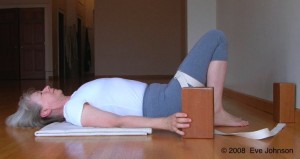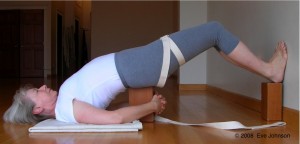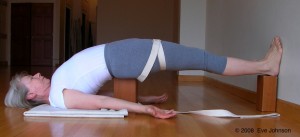As quiet as a yoga practice may be, the mat is a busy construction site. We make triangles, bound angles, side angles, plows, boats, half-boats, gates, bows, and yes, bridges.
And you can’t make a bridge without raising the idea of crossing it.
If you see the pose as the bridge, then Setu Bandha Sarvangasana (literally: bridge lock all-limbs pose) is a bridge we can cross into shoulder stand because it creates the required openings in the chest and shoulders.
Reduce the muscular effort and increase the length of holding in a supported bridge pose, and you’re offered a crossing from the busy mind into quiet.
But when the body is the bridge, and you are the mind in the body, consciously interpenetrated, what happens then?
What do you span? What are the two sides you join? Where do you go when you cross the bridge? Do you cross from feet to head or from head to feet? Or is there an alternating flow? Or a simultaneous flow in both directions?
You tell me.
I won’t call this practice suggestion a Five-Minute Yoga Challenge, because it’s going to take at least 10 by the time you set it up and stay long enough to build your bridge.
But if you struggle to find time for yoga, I suspect you aren’t suffering from too much rest, at least not the deep organic rest of a supported pose.
Supported Setu Bandhasana will not only rest your heart, cool and soothe your busy brain, give you a gentle abdominal stretch and expand your chest, it’s also a great way to counter the effects of a day spent sitting.
Once shoulder stand is part of your practice, do supported bridge pose after you practice shoulder stand. You’ll find it helps relax and release your upper body. If you’re not yet working with shoulder stand on your own, place this pose toward the end of your practice as a way to quiet down and prepare for Savasana (relaxation pose).
Here’s how:
Lie down on the floor with your knees bent and a belt tied around your upper thighs. As you tie the belt, make sure your upper inner thighs roll in.
The belt will help you hold that action in the pose.
Have a blanket under your shoulders and at least one wood or dense foam yoga brick. The second brick, which supports your heels at the wall, can be chip foam blocks or a stack of books. Place the support for your heels at the wall.
Press your feet into the floor and lift your buttocks as high as you can. Come onto your toes to get more height.
Slip the brick, on its tall side, under your sacrum – the bony triangle at the base of your spine. Make sure that your sacrum rests comfortably on the brick. Place the brick closer to your tailbone than to your waist.
Now place your heels on the brick at the wall. Hold the brick under your sacrum in place with your hands, and straighten your legs. If you are practicing on a hardwood floor or other smooth surface, you will slide backwards until your legs are straight.
If your practice space is carpeted, check your distance from the wall. Ideally, your heels and big toe mounds will both contact the wall strongly with your legs straight. If you can’t straighten your legs, or if your feet lose contact with the wall, bring your feet back to the floor, remove the brick, and adjust the distance.
Press deeply into the wall with your feet. Spread the toes wide. Bring your inner knees, inner ankles, and sides of your big toes to touch each other.
Begin to adjust your upper body.
Bend your elbows and press down into your upper arms and the back of your head. Your shoulders should lift away from the floor. Roll your upper arms to face the ceiling.
As you bring your shoulders back to the floor, focus on keeping your weight on the outer shoulders, away from your spine. Press your shoulder blades into your back ribs to help lift and open your chest.
Check that the back of your neck still has a natural curve. If you feel strain at the back of your neck, lift your chin slightly away from your chest. If that doesn’t solve the problem, come out and put another folded blanket under your shoulders.
Now cross the Setu Bandhasana bridge into your inner body. Withdraw your senses of sight and hearing from the surface. Without pulling your breath or straining, watch as the inhalation fills your ribcage. Without tensing your body, keep what you can of your chest expansion as you exhale.
Stay for a few minutes the first time you try the pose. As you get used to it, lengthen your stay. Five minutes is a reasonable goal, 10 can be wonderful.
When you’re ready to come out, bring both feet to the floor. Press down with your feet to lift your pelvis. Remove the brick, and let your buttocks sink back to the floor.
Rest on the floor with your knees bent for a breath or two, then roll to the right-hand side and sit up.
Ouch: If the brick feels uncomfortable, you may have it in the wrong place. Check that it’s not too close to your waist.
Sometimes the shape of the sacrum makes the brick more comfortable when
it’s turned sideways (still on its high side).
If your lower back hurts, bring your feet to the floor. If it still hurts, work with less height under your pelvis. Try one or two chip foam blocks to start.
If you already have neck pain, ask your teacher to show you a variation that will work for you.
Image courtesy of Alan Cleaver at Flickr Creative Commons
If this was your kind of post, you might also like:
Find a Time of Day to Watch Your Breath
Disarm Practice Resistance With Small Steps, and Viparita Karani








Comments on this entry are closed.
Hello Jenn,
I tried with two foam blocks standing tall next to each other under the sacrum and felt better.
Thanks for this Eve. This is a troublesome pose for me. I find, no matter how I lay the brick or how small I may adjust it on my sacrum, it is painful. Whether it is the high density foam square blocks or the wood block, it’s is painful. I suppose I could just stack some chip foam blocks. I wonder though, am I the only one out there who feels the block on my sacrum as a very intense pain?
What would you suggest I try?
Hey Jenn,
You’re not the only one who finds this pose problematic.
I think I’d just keep working with the chip foams, and trying the wood block once every six months or so.
If I get a chance to ask someone who might have a better idea, I will. And if anyone else has a thought on the subject, please chime in.